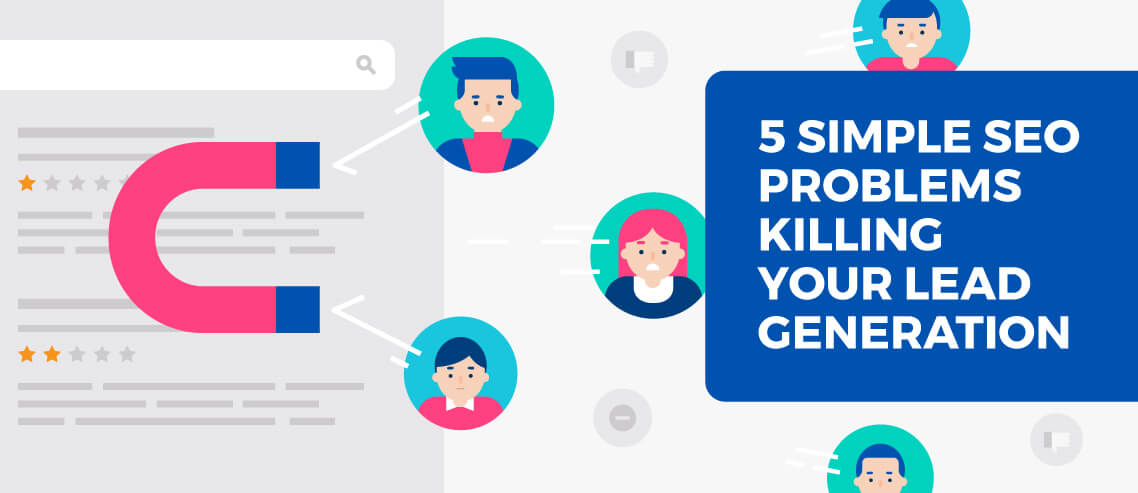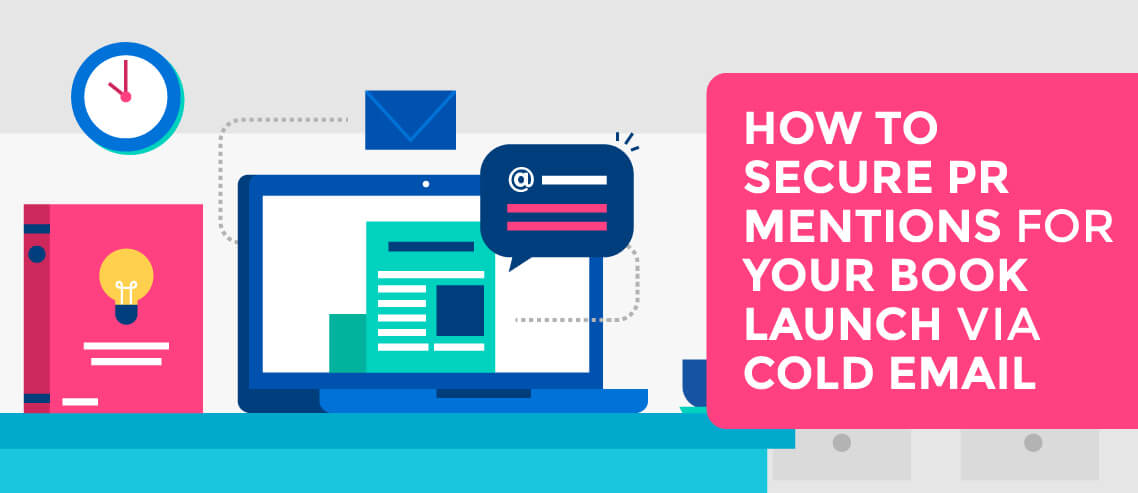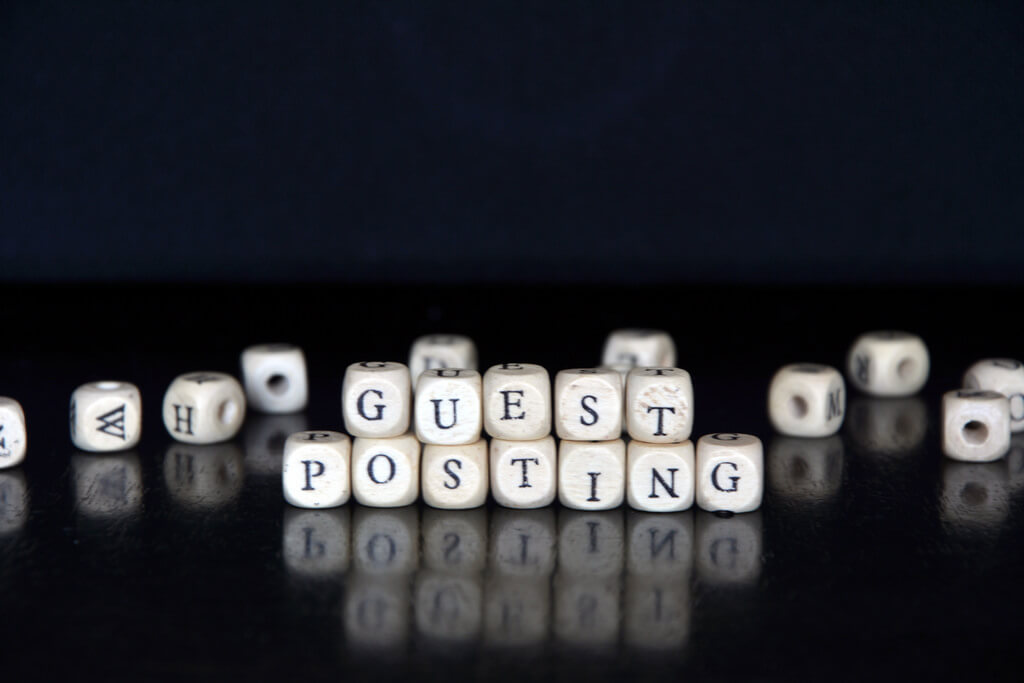How to Perform Cold Email Outreach for PR

Contents
Business is all about relationships: relationships with your customers, employees, manufacturers, distributors, influencers, and even your competition. You cultivate and develop those relationships through a wide variety of channels, such as social media, live events, paid advertising, and both cold and warm email.
But you not only have to maintain those existing connections, you also have to reach out and make new ones. Whether for expansion, rebranding, retention, or launching a new product or service, making fresh connections and forming new relationships consistently is key to business growth. And in order to do this successfully, you need the right tools in your arsenal.
This is where public relations (PR) comes in.
Public Relations
So what exactly is PR?
Marketing and advertising are pretty straightforward. They try to introduce and persuade you to buy something at some point.
But PR is not quite so obvious. Think of it as the ultimate relationship-builder. Public relations is building and maintaining the relationship between you, your brand, your products, and the public.
“Public relations in general is selling awareness, reputation, and changes in behavior. It’s a game-changer with one of the highest ROIs of any marketing/communications activity. Public relations builds top of mind awareness and sometimes explosive visibility for brands, products and thought leaders.”
~Joel Swanson, Director of Messaging and Marketing Communications at UnitedHealth Group
As the name suggests, PR is establishing a positive reputation with the public, or more specifically, your public.
But unlike traditional advertising, PR is typically earned or unpaid media attention. You’re not paying for a 30-second radio or PPC ad.
PR professionals use the power of storytelling to bring attention and publicity to you for the good stuff, and away from you for the bad stuff (damage control).
With that in mind, it might be easy to dismiss public relations as nothing more than media relations. You wouldn’t be the first person to have that opinion.
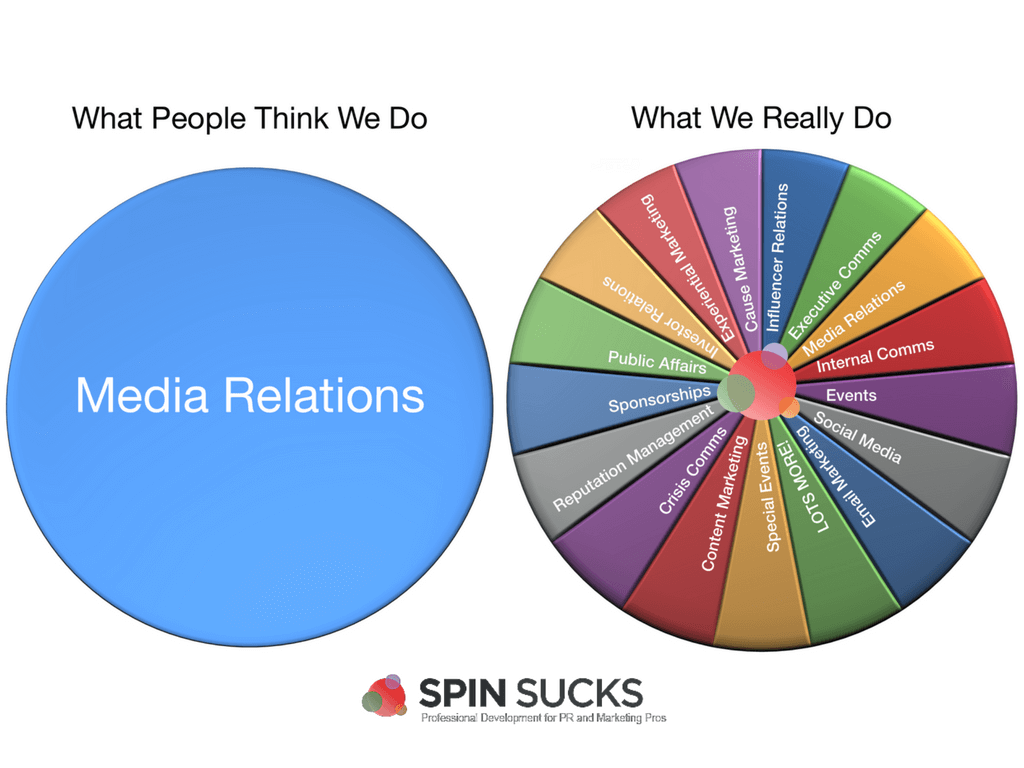
But that’s a narrow view, as seen in the chart above. PR has many, many moving parts and cogs in the machine.
And as we move away from the traditional advertising model, public relations is becoming increasingly important for business success:
- 86% of people skip over television commercials, and 44% of direct mail is never opened.
- 70% of consumers prefer learning about a particular company or brand via articles rather than paid ads, and that figure jumps to 80% for business decision-makers.
- Millennials are 247% more likely to be influenced by social media or blogs.
- Managing your reputation is crucial in the digital world, as it takes only two hours to confirm a true rumor, but an average of at least 14 hours to debunk a false one. You need someone paying attention and ready to spring into action.
- PR needs to include more than just press releases. 73% of journalists do look for new and intriguing press releases daily … but that means 27% don’t bother. How can you reach that untapped market?
- The use of ad-blockers was up 30% in 2017, a trend likely to continue in 2018 and beyond.
A PR pro must be a jack-of-all-trades and a powerful storyteller. They may be involved in 10, 15, 20 or more channels and tactics.
But here’s what I want you to remember if you take just one thing away from this post:
92% of influencers and journalists still prefer email pitches and outreach over other channels.
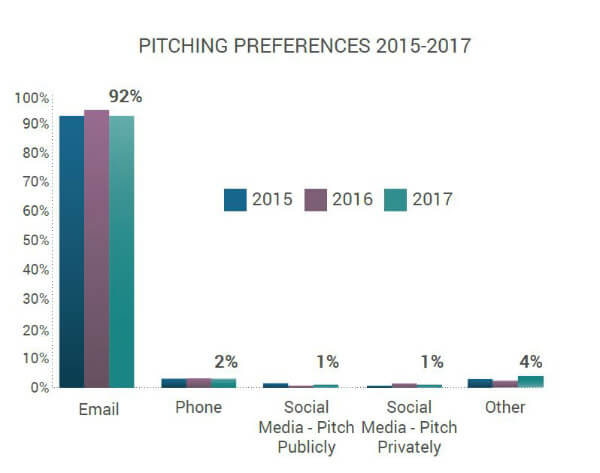
Ah, the pitch; the stalwart of the PR tool belt. As you can see, the overwhelming preference for how to get that pitch in front of the right eyes is email.
A well-written and well-timed email pitch – 61% like to receive them in the morning, 30% in the afternoon, and 9% in the evening – can deliver a seriously effective bang for your metaphorical buck (it is earned media, after all).
So whether you’re reaching out to journalists, influencers, or local businesses, you should be a) pitching the right way, and b) sending pitches out via email.
Pitch. Email. Control your narrative.
Email Outreach in PR
The most important way to rise above the email masses – we send roughly 269 billion of them each day – is to make them personalized and individual. No one wants to respond to an email that was very clearly sent to dozens of other people too.
Rookie mistakes that’ll cost you? Including other recipients in the CC: field, and sending an email completely lacking in personalization.
To combat that, never, ever send the exact same email to more than one person, and remember these three little words: research, research, research.
To find a few potential targets, conduct a Google search on a corresponding keyword or topic, or find the most popular content on a particular subject with a tool like BuzzSumo. Those are the writers and bloggers you’re looking for. Or turn to a third-party solution like Muck Rack for a ready-to-use media database.
Next, answer a few questions about them: who are you pitching, what do they usually write about, what’s their most recent, relevant success you could mention, do you have an existing connection, and most importantly, how will your pitch benefit them and their readers? Find out everything you can about them, their body of work, their readers, their publication, and so on.
The more you know and include, the better.
The Perfect Pitch
Every good pitch has at least three things in common: a hook, a clear call-to-action, and an irresistible value proposition.
The Hook
Your hook is the angle you’re pitching. Generally speaking, PR pitches to journalists and influencers have either a news peg – connected in some meaningful way to a current topic or story – or a time peg – connected to an upcoming anniversary, date, or event.
If you’ve got a strong, meaningful news or time peg, you’re halfway home.
The Call-to-Action
Any email – or landing page or social media post, or whatever – has one specific action you want your reader to take. A pitch isn’t any different.
What exactly do you want the recipient to do? Contact your client, research a regulatory change, publish an update, interview a CEO, review a product, or something else entirely?
Be clear and explicit on what you want your reader to do.
Value Proposition
The most important element of a successful PR pitch is the value prop. It’s here that you make clear why they should cover this story, how it connects to some larger topic or issue, and why it would benefit their readers, followers, and publication.
It needs to be about them, not about you. A good pitch should be or at least seem like you’re doing them a favor, and not the other way around.
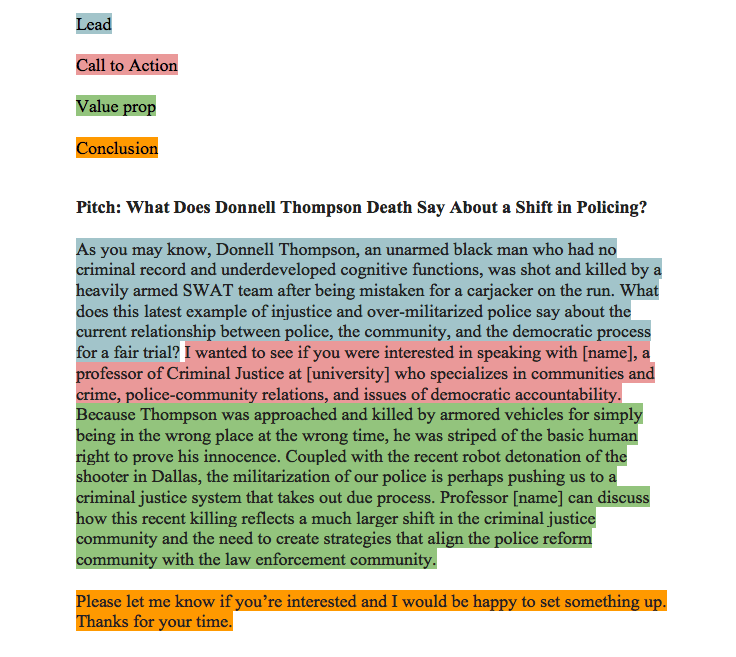
And remember that just because an email is cold doesn’t mean it can’t be personalized.
Tips and Tricks
Beyond using the battle-tested structure above, there are a few other tips recommended by PR pros to give you an even bigger advantage:
- Don’t pitch an idea about organic produce delivery to a technology reporter. Make sure your story syncs with their usual subject matter. Seems obvious, but you’d be surprised how many “pros” fail to do so.
- Link to relevant stats, data, and articles to strengthen your pitch.
- Link to bios of individuals and research or data that you mention in the pitch. This makes it fast, easy, and convenient for your recipients to dig a little deeper and pique their interest.
- Whenever possible, make your pitch an exclusive one. Offer it to someone else only if and when they pass on it.Aim to offer them something that enhances a story they’re writing or resolves a pain point. I recently had an exchange where I asked for a link for an email verification tool I recently acquired to be included in one of their top performing posts on email list growth.
- Don’t beat around the bush. Get to the point, and get to it quickly. Everyone is busy.
- Personalize each pitch as much as you can.
- Keep the subject line short and simple. Ambitious? Test different subject lines to zero in on the most effective.
- As a complement to but not a replacement for your PR outreach, consider using Help a Reporter Out (HARO). This service connects journalists and sources. Good for them, and good for you.
Don’t put in the effort and/or make glaring mistakes, and you’re wasting everyone’s time.
Automate? Yes You Can.
A ‘spray and pray” campaign – sending out the same email to dozens or hundreds of recipients – is not going to deliver. It just won’t.
But that doesn’t mean you can’t use automation and scale up your outreach efforts.
A well-crafted template with ample opportunity for personalization via merge fields and tags does it all. You can automatically drop in personal information on everything from names, companies, publications, recent articles, and more to make your customizable template the perfect fit for more than just one recipient and more than one situation.
Automate your basic and initial interactions with a full-service solution like Mailshake, but be sure and manually take hold of the reins once they’ve taken the first nibble.
How? With action-based segmentation and collection. Using Mailshake’s Lead Catcher, for example, you can set an appropriate trigger to shift recipients from your automated list to a manual list once they’re warmed and ready to engage. That trigger can be a response, or a link click, or whatever.
Reach out automatically, set your response criteria, and respond in person when that trigger is met.
The best of both worlds.
Follow-Up
You’ve heard this advice before. You’ve got to follow up.
70% of unanswered sales email chains stop after email #1. Be different. Be in that 30% minority and keep sending.
Why? In short, because the more you send, the more responses you’ll see: a 30% response rate to the first email, but 21% to the second, 18% to the third, all the way to 7% for the tenth.
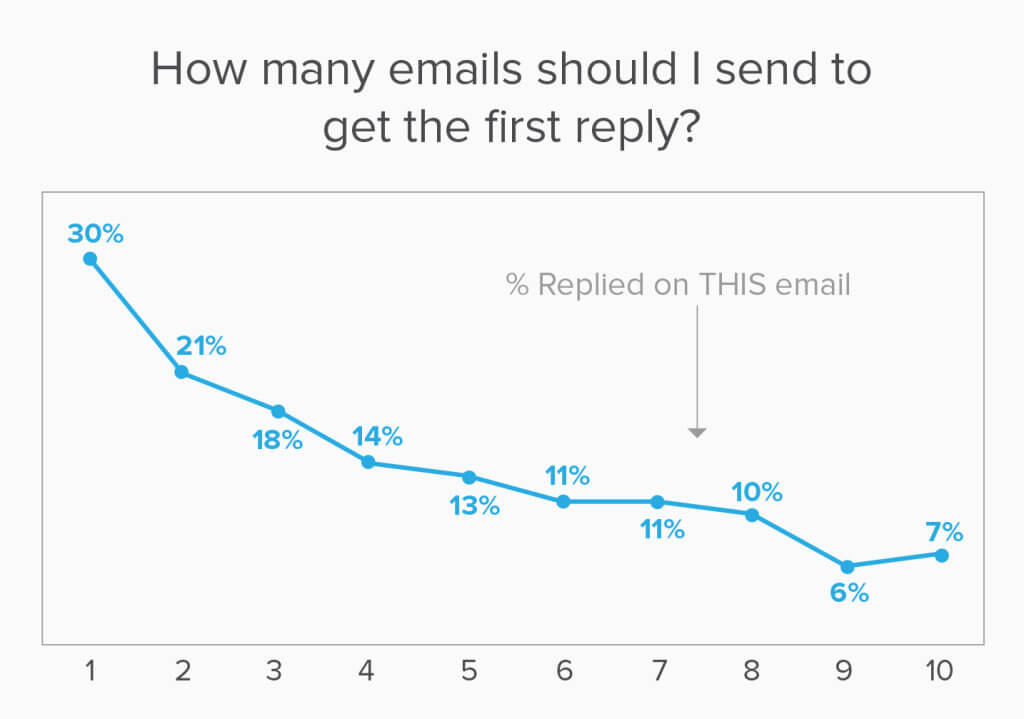
Whether it’s a book launch, product update, or new service, public relations works with your paid marketing to cover all bases and reach all publics.
Cold email works for sales and marketing, of course.
But PR outreach is the lesser-known – but no less necessary and effective – sibling. So pitch by email. Be persuasive. Follow up.
And control your story.


